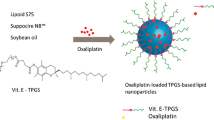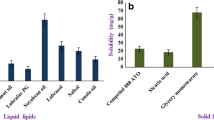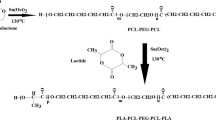Abstract
Colon cancer is one of the most life-threatening cancers with high incidence and mortality rates. Current first-line treatments are ineffective and possess many unwanted effects. The off-label use of paclitaxel encapsulated in nanoparticles proves an innovative approach. In this study, we reported novel paclitaxel loaded EDC-crosslinked fibroin nanoparticles (PTX-FNPs) for anticancer purpose. The particles were formulated using desolvation method and the physicochemical properties were controlled favorably, including the particle size (300–500 nm), zeta potential (− 15 to + 30 mV), drug entrapment efficiency (75–100%), crystallinity, drug solubility (1- to 10-fold increase), dissolution profiles, stability (> 24 h in intravenous diluent and > 6 months storage at 4 °C). In in vitro study, all formulations showed no toxicity on the red blood cells, whereas retained the paclitaxel cytotoxicity on MCF-7 breast cancer and Caco-2 colon cancer cells. Interestingly, PTX-FNPs can be uptaken rapidly by the Caco-2 cells, consequently increased paclitaxel potency up to 10-fold compared to the free drug.

Graphical abstract







Similar content being viewed by others
References
Bray F, Ferlay J, Soerjomataram I, Siegel RL, Torre LA, Jemal A. Global cancer statistics 2018: GLOBOCAN estimates of incidence and mortality worldwide for 36 cancers in 185 countries. CA Cancer J Clin. 2018;68(6):394–424. https://doi.org/10.3322/caac.21492.
Van Cutsem E, Cervantes A, Adam R, Sobrero A, Van Krieken JH, Aderka D, et al. ESMO consensus guidelines for the management of patients with metastatic colorectal cancer. Ann Oncol. 2016;27(8):1386–422. https://doi.org/10.1093/annonc/mdw235.
Temraz S, Mukherji D, Alameddine R, Shamseddine A. Methods of overcoming treatment resistance in colorectal cancer. Crit Rev Oncol Hematol. 2014;89(2):217–30. https://doi.org/10.1016/j.critrevonc.2013.08.015.
Jordan MA, Wilson L. Microtubules as a target for anticancer drugs. Nat Rev Cancer. 2004;4(4):253–65. https://doi.org/10.1038/nrc1317.
McGrogan BT, Gilmartin B, Carney DN, McCann A. Taxanes, microtubules and chemoresistant breast cancer. Biochim Biophys Acta. 2008;1785(2):96–132. https://doi.org/10.1016/j.bbcan.2007.10.004.
Gelderblom H, Verweij J, Nooter K, Sparreboom A. Cremophor EL: the drawbacks and advantages of vehicle selection for drug formulation. Eur J Cancer. 2001;37(13):1590–8. https://doi.org/10.1016/S0959-8049(01)00171-X.
Sparreboom A, van Tellingen O, Nooijen WJ, Beijnen JH. Nonlinear pharmacokinetics of paclitaxel in mice results from the pharmaceutical vehicle Cremophor EL. Cancer Res. 1996;56(9):2112–5.
Kundranda MN, Niu J. Albumin-bound paclitaxel in solid tumors: clinical development and future directions. Drug Des Devel Ther. 2015;9:3767–77. https://doi.org/10.2147/DDDT.S88023.
Matsumura Y, Maeda H. A new concept for macromolecular therapeutics in cancer chemotherapy: mechanism of tumoritropic accumulation of proteins and the antitumor agent smancs. Cancer Res. 1986;46(12 Pt 1):6387–92.
Ducreux M, Bennouna J, Adenis A, Conroy T, Lièvre A, Portales F, et al. Efficacy and safety of nab-paclitaxel in patients with previously treated metastatic colorectal cancer: a phase II COLO-001 trial. Cancer Chemother Pharmacol. 2017;79(1):9–16. https://doi.org/10.1007/s00280-016-3193-5.
Yusuf RZ, Duan Z, Lamendola DE, Penson RT, Seiden MV. Paclitaxel resistance: molecular mechanisms and pharmacologic manipulation. Curr Cancer Drug Targets. 2003;3(1):1–19. https://doi.org/10.2174/1568009033333754.
Sheppard BC, Rutten MJ, Meichsner CL, Bacon KD, Leonetti PO, Land J, et al. Effects of paclitaxel on the growth of normal, polyposis, and cancerous human colonic epithelial cells. Cancer. 1999;85(7):1454–64. https://doi.org/10.1002/(SICI)1097-0142(19990401)85:7<1454::AID-CNCR5>3.0.CO;2-%23.
Ma P, Mumper RJ. Paclitaxel nano-delivery systems: a comprehensive review. J Nanomed Nanotechnol. 2013;4(2):1000164. https://doi.org/10.4172/2157-7439.1000164.
Danhier F, Lecouturier N, Vroman B, Jérôme C, Marchand-Brynaert J, Feron O, et al. Paclitaxel-loaded PEGylated PLGA-based nanoparticles: in vitro and in vivo evaluation. J Control Release. 2009;133(1):11–7. https://doi.org/10.1016/j.jconrel.2008.09.086.
Forrest ML, Yáñez JA, Remsberg CM, Ohgami Y, Kwon GS, Davies NM. Paclitaxel prodrugs with sustained release and high solubility in poly(ethylene glycol)-b-poly(epsilon-caprolactone) micelle nanocarriers: pharmacokinetic disposition, tolerability, and cytotoxicity. Pharm Res. 2008;25(1):194–206. https://doi.org/10.1007/s11095-007-9451-9.
Kim K, Kim JH, Park H, Kim YS, Park K, Nam H, et al. Tumor-homing multifunctional nanoparticles for cancer theragnosis: simultaneous diagnosis, drug delivery, and therapeutic monitoring. J Control Release. 2010;146(2):219–27. https://doi.org/10.1016/j.jconrel.2010.04.004.
Zhang JA, Anyarambhatla G, Ma L, Ugwu S, Xuan T, Sardone T, et al. Development and characterization of a novel Cremophor EL free liposome-based paclitaxel (LEP-ETU) formulation. Eur J Pharm Biopharm. 2005;59(1):177–87. https://doi.org/10.1016/j.ejpb.2004.06.009.
Lee MK, Lim SJ, Kim CK. Preparation, characterization and in vitro cytotoxicity of paclitaxel-loaded sterically stabilized solid lipid nanoparticles. Biomaterials. 2007;28(12):2137–46. https://doi.org/10.1016/j.biomaterials.2007.01.014.
Constantinides PP, Lambert KJ, Tustian AK, Schneider B, Lalji S, Ma W, et al. Formulation development and antitumor activity of a filter-sterilizable emulsion of paclitaxel. Pharm Res. 2000;17(2):175–82. https://doi.org/10.1023/A:1007565230130.
Gibson JD, Khanal BP, Zubarev ER. Paclitaxel-functionalized gold nanoparticles. J Am Chem Soc. 2007;129(37):11653–61. https://doi.org/10.1021/ja075181k.
Hua MY, Yang HW, Chuang CK, Tsai RY, Chen WJ, Chuang KL, et al. Magnetic-nanoparticle-modified paclitaxel for targeted therapy for prostate cancer. Biomaterials. 2010;31(28):7355–63. https://doi.org/10.1016/j.biomaterials.2010.05.061.
Mottaghitalab F, Farokhi M, Shokrgozar MA, Atyabi F, Hosseinkhani H. Silk fibroin nanoparticle as a novel drug delivery system. J Control Release. 2015;206:161–76. https://doi.org/10.1016/j.jconrel.2015.03.020.
Zhao Z, Li Y, Xie MB. Silk fibroin-based nanoparticles for drug delivery. Int J Mol Sci. 2015;16(3):4880–903. https://doi.org/10.3390/ijms16034880.
Chen M, Shao Z, Chen X. Paclitaxel-loaded silk fibroin nanospheres. J Biomed Mater Res A. 2012;100(1):203–10. https://doi.org/10.1002/jbm.a.33265.
Wu P, Liu Q, Li R, Wang J, Zhen X, Yue G, et al. Facile preparation of paclitaxel loaded silk fibroin nanoparticles for enhanced antitumor efficacy by locoregional drug delivery. ACS Appl Mater Interfaces. 2013;5(23):12638–45. https://doi.org/10.1021/am403992b.
Zhao Z, Li Y, Zhang Y. Preparation and characterization of paclitaxel loaded SF/PLLA-PEG-PLLA nanoparticles via solution-enhanced dispersion by supercritical CO2. J Nanomater. 2015;913254. https://doi.org/10.1155/2015/913254.
Wu M, Yang W, Chen S, Yao J, Shao Z, Chen X. Size-controllable dual drug-loaded silk fibroin nanospheres through a facile formation process. J Mater Chem B. 2018;6:1179–86. https://doi.org/10.1039/C7TB03113K.
Pham DT, Saelim N, Tiyaboonchai W. Crosslinked fibroin nanoparticles using EDC or PEI for drug delivery: physicochemical properties, crystallinity and structure. J Mater Sci. 2018;53(20):14087–103. https://doi.org/10.1007/s10853-018-2635-3.
Pham DT, Saelim N, Tiyaboonchai W. Design of experiments model for the optimization of silk fibroin based nanoparticles. Int J App Pharm. 2018;10(5):195–201. https://doi.org/10.22159/ijap.2018v10i5.28139.
Liggins RT, Hunter WL, Burt HM. Solid-state characterization of paclitaxel. J Pharm Sci. 1997;86(12):1458–63. https://doi.org/10.1021/js9605226.
Pham DT, Saelim N, Tiyaboonchai W. Alpha mangostin loaded crosslinked silk fibroin-based nanoparticles for cancer chemotherapy. Colloids Surf B: Biointerfaces. 2019;181:705–13. https://doi.org/10.1016/j.colsurfb.2019.06.011.
Israelachvili J. Intermolecular & Surface Forces. 3rd ed. Cambridge: London Academic Press; 1985.
Macpherson SA, Webber GB, Moreno-Atanasio R. Aggregation of nanoparticles in high ionic strength suspensions: effect of Hamaker constant and particle concentration. Adv Powder Technol. 2012;23(4):478–84. https://doi.org/10.1016/j.apt.2012.04.008.
Schinkel AH, Mayer U, Wagenaar E, Mol CA, van Deemter L, Smit JJ, et al. Normal viability and altered pharmacokinetics in mice lacking mdr1-type (drug-transporting) P-glycoproteins. Proc Natl Acad Sci U S A. 1997;94(8):4028–33. https://doi.org/10.1073/pnas.94.8.4028.
Hoskins J, DeHerdt SV, Moore RE, Bumol TF. The development and characterization of Vinca alkaloid-resistant Caco-2 human colorectal cell lines expressing mdr-1. Int J Cancer. 1993;53(4):680–8. https://doi.org/10.1002/ijc.2910530426.
Yamada H, Igarashi Y, Takasu Y, Saito H, Tsubouchi K. Identification of fibroin-derived peptides enhancing the proliferation of cultured human skin fibroblasts. Biomaterials. 2004;25(3):467–72. https://doi.org/10.1016/S0142-9612(03)00540-4.
Desgrosellier JS, Cheresh DA. Integrins in cancer: biological implications and therapeutic opportunities. Nat Rev Cancer. 2010;10(1):9–22. https://doi.org/10.1038/nrc2748.
Bray LJ, Suzuki S, Harkin DG, Chirila TV. Incorporation of exogenous RGD peptide and inter-species blending as strategies for enhancing human corneal limbar epithelial cell growth on Bombyx mori silk fibroin membranes. J Funct Biomater. 2013;4(2):74–88. https://doi.org/10.3390/jfb4020074.
Acknowledgments
Duy Toan Pham thanks Naresuan University ASEAN Scholarship, the RGJ Ph.D. Grant, the Boosting Research Potential for NU Students (Batch 4) Fellowship, and the Naresuan University Scholarship for Oral Presentation for funding his doctoral study. We also want to thank the staff of the Faculty of Pharmaceutical Sciences, Naresuan University, for their kind guidance. Thank you, mom, dad, and Phung for everything.
Funding
This study received financial support from the Thailand Research Fund (TRF) under the Royal Golden Jubilee (RGJ) Ph.D. Grant No. PHD/0234/2560 RGJ and the Naresuan University Grant No. R2561B009.
Author information
Authors and Affiliations
Corresponding author
Ethics declarations
Conflict of interest
The authors declare that they have no conflict of interest.
Additional information
Publisher’s note
Springer Nature remains neutral with regard to jurisdictional claims in published maps and institutional affiliations.
Highlights
- Novel paclitaxel loaded EDC-crosslinked silk fibroin nanoparticles were developed.
- Particle properties were controlled favorably.
- All formulations were non-toxic to the red blood cells and retained paclitaxel action on Caco-2 and MCF-7 cancer cell lines.
- In Caco-2 cells, the particles increased paclitaxel potency up to 10-fold.
Rights and permissions
About this article
Cite this article
Pham, D.T., Saelim, N. & Tiyaboonchai, W. Paclitaxel loaded EDC-crosslinked fibroin nanoparticles: a potential approach for colon cancer treatment. Drug Deliv. and Transl. Res. 10, 413–424 (2020). https://doi.org/10.1007/s13346-019-00682-7
Published:
Issue Date:
DOI: https://doi.org/10.1007/s13346-019-00682-7




